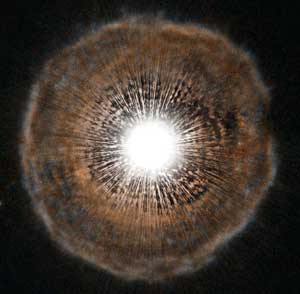Create a free profile to get unlimited access to exclusive videos, sweepstakes, and more!
Similar by eye, not by nature

In a funny coincidence, my friend Travis Rector, an astronomer at the University of Alaska who takes amazing and incredibly beautiful astrophotographs, posted an image that may look familiar. It's of NGC 6751, a planetary nebula about 5000 - 7000 light years away:
[Click to embiggen, and note I rotated the image 90° to make it fit better on the blog.]
It's very pretty, but also very complex. Planetary nebulae are actually gaseous structures created when stars a bit more massive than the Sun die. When they turn into red giants they blow a dense, slow wind of gas into space -- that can be seen in NGC 6751 as the big blue halo surrounding the whole thing. The edge is a bit brighter as it slams into gas floating in between the stars and piles up a bit. The halo is probably something like 1.5 light years across.
The interior part is actually the most interesting, You can see the star in the center. About halfway out to the big halo is a ring of material that looks like it's broken up into individual knots like pearls on a necklace. Inside that ring is something that looks like a disk seen face-on, with faint filaments stretching from the central star out to the ring.
Studies of this object indicate this is in fact the case. Although it's not clear, I suspect the central star may have enveloped and swallowed a companion star or giant planet, spinning it up to a much faster rotation speed. Otherwise, it's hard to explain why it has a ring and disk of material; a solitary star could never spin fast enough to eject such a structure. This would also explain some of the more complex features of the nebula as well. If this is true, we're nearly roughly down on the pole of the star (or maybe off by 20° or so), since the disk is very close to being a circle; if the system were tilted by much more the ring would be more elliptical, like looking at the rim of a glass from an angle.
 Anyway, I said this nebula may look familiar; that's because I recently posted a picture of the star U Cam, which is much like the Sun but a lot older. Like the central star of NGC 6751, it too is dying, but in the case of U Cam it's blasting out shells of material on a very short timescale. The ring we see around it is only about 700 years old, and was created in an event that lasted mere decades. The shells and rings in NGC 6751 took thousands of years to make, and the halo is probably more than 50,000 years old!
Anyway, I said this nebula may look familiar; that's because I recently posted a picture of the star U Cam, which is much like the Sun but a lot older. Like the central star of NGC 6751, it too is dying, but in the case of U Cam it's blasting out shells of material on a very short timescale. The ring we see around it is only about 700 years old, and was created in an event that lasted mere decades. The shells and rings in NGC 6751 took thousands of years to make, and the halo is probably more than 50,000 years old!
And while both huge structures are the results of dying stars, and both have an overall similar appearance, they're very different in actual shape and origin. The halo around U Cam is like a soap bubble: a thin shell that has a sharp edge but is probably mostly empty on the inside. Astronomers call this a "detached shell". NGC 6751, on the other hand, is more like a balloon filled with gas. And down near the star NGC 6751 has that complex disk/ring affair going on, while U Cam is probably mostly empty space all the way down to the surface of the star. The gas making up the shell of U Cam has about the same mass as the Earth, while the nebula in NGC 6751 is tens of thousands times more massive!
There are lots of other differences between them as well, but I find it remarkable (literally, since I've been sitting here remarking on it!) that two objects with such similar appearance - and both caused by the efforts of dying stars - can actually be so different. Nature is filled with such things, of course. Spiral galaxies look similar to swirls of cream in a coffee cup, though the physics is entirely different. Stars and drops of water are spherical, but for two different reasons (gravity for the stars, surface tension for the droplets).
Sometimes moons look like Death Stars, but that may be pushing this a bit too far.
I think that's cool. Shapes of objects can be revealing of their nature, but you have to be careful when making judgement based on shape alone. You have to look deeper to reveal the true nature.
If there's a life lesson in that, feel free to find it on your own.
Image credit: D. Tran (PAL College), T.A. Rector (University of Alaska Anchorage), T. Bridges (Queen's U.) and the Australian Gemini Office
Related Posts:
- The Ghost in the Shell
- Tears of a dying star
- The green ghost of a distant dead star
- The knotty halo of the Catâs Eye



























